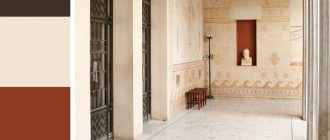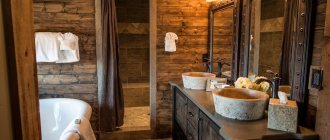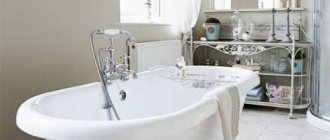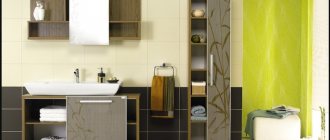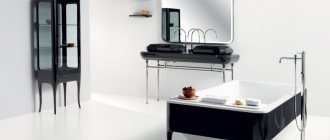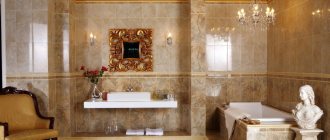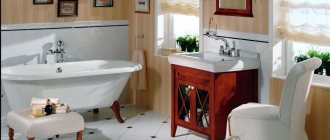Nowadays, the interior is quite popular, which suggests the presence of different styles in the design of the room. For example, a Greek-style bathroom is often found. True, it is important to understand here that in this case we are not referring to the modern state and its culture, but to the period of antiquity.
It should be noted that Greece is a state with a thousand-year history and culture. Over the entire existence of the country, leading figures of the state have done a lot in the field of science, and also reached heights in other fields. Let's say, if we talk about the construction of premises and improvement, then Greek architects and designers managed to exceed all the hopes that were placed on them.
Nowadays, the interior is quite popular, which involves the presence of various styles in the design of the room.
It is no secret that the ancient Greeks greatly appreciated art and everything beautiful that surrounded them. They were directly involved in the formation of individual styles and design innovations. This served as a huge impetus for the development of a common global design direction. Based on all of the above, it is quite logical that even today the Greek style is present in many interiors.
The era of the origin of this style is considered to be the last century. It was during this period that the peak of popularity of the Greek style in the interior occurred.
The era of the origin of this style is considered to be the last century. It was during this period that the popularity of the Greek style in the interior peaked. But, fortunately, even to this day it has not lost its popularity and is still actively used in premises for various purposes.
It is no secret that the ancient Greeks greatly appreciated art and everything beautiful that surrounded them. They were directly involved in the formation of individual styles and design innovations
A little history
But first, let’s pay attention to the history of the emergence of this trend in the interior in order to better understand it. And this will help in its correct implementation.
It must be said that the ancient Greeks did not particularly care about the interior design of the premises. Thanks to the warm climate, they were most often outdoors, so the decoration in the houses had rough features, and the shapes of the furniture were characterized by primitivism. It was later, with the development of civilization, that the Greeks began to gravitate towards luxury.
Coffered ceilings were invented by the ancient Greeks. They came up with the idea of replacing the column using a female statue. By the way, this decision appeared after well-known events, when in the city of Karia the female half of society found themselves in heavy slavery.
The Greek zigzag pattern is a symbol of the Meander River, which has similar bends.
Who is it suitable for?
Greek style is one of the classic trends in design. It can be called universal, since the calm and nobility of this style is suitable for decorating a wide variety of rooms and is liked by a variety of people. However, there are categories of people who will especially like the Greek interior:
- Owners of spacious apartments in “Stalin” or new buildings, as well as those who live in country houses. In order for a Greek-style interior to look properly, large areas and high ceilings are required. Only in this case will the arched vaults and marble-clad columns look harmonious.
- Connoisseurs of the classics. If you are far from modern culture, then you are unlikely to like the latest trends in apartment design (such as loft or fusion). In this case, the simplicity and harmony of the Greek style, in which there is nothing superfluous and every thing has its place, is exactly your option.
Style Features
Let us immediately note that very often the Greek direction is confused with the Roman one. Of course, this is incorrect, since the styles are very different. For Roman, luxury is more relevant, while for Greek, confident simplicity is more relevant. The Greek-style bathroom features frescoes, fairly high ceilings and characteristic stucco. And it is important that the color scheme has a natural basis.
Pastel colors are used in this direction: delicate lemon and olive, blue shades. The Greek style rejects bright colors and gilding. Let elegance remain, but it should not turn into pompous luxury. Restraint is encouraged.
Ceramic tiles, wood, stone, marble and even granite can be used as finishing materials. Of course, Greek-style bathroom tiles are the simplest solution, since this material is traditional for decorating this room.
Expressive elements of the Greek style are columns. They add a sense of grandeur to the interior.
Despite a certain asceticism in decoration, expressive decorative items are used. These can be large vases, mirror paintings, figurines.
Functionality and practicality of a Mediterranean bathtub
PreviousNext
The walls and ceiling can be finished with light ceramics or tiles, which are easy to clean.
Regular tiles are also suitable, but it is better if several color shades are used. For example, an azure-colored mosaic will look great on the walls.
A perfect addition here would be a floor with terracotta tiles.
Furniture is selected using the same principle: a variety of shelves and wall cabinets in blue and/or terracotta colors, wicker baskets. Even towel holders and coat hooks should be in a common style, not necessarily in the same colors, it can be any shade that represents the sea, sky, sun and beach, for example, sand, yellow, orange, turquoise and so on.
It is possible to finish the walls and ceiling with white paint - this is in the spirit of the Mediterranean style of the Greek orientation.
Here the emphasis is on the natural roughness of uneven walls and ceilings, which not only emphasizes the simplicity of the interior, but also saves time, money and effort on leveling surfaces. To create a slant towards Italian and Spanish notes, a combination of several textures is used in wall decoration. This can be decorative plaster, mosaic tiles, imitation frescoes and wall painting.
For flooring, in addition to terracotta tiles, tiles in warm colors are often used: brown, beige, sand, brick, ocher, and so on.
Wall decoration
Greek style bathroom design requires the use of certain materials. Wallpaper is not an option you should think about. More attention needs to be paid to more “ancient” materials, for example, plaster. It can be painted in light colors.
You can decorate surfaces with ornaments, using, for example, the same Greek zigzag pattern. You can also make a painting on a mythological theme. It can be a unique addition to your interior design.
Color solutions
Like any other room decorated in Greek style, the bathroom should be done in light colors. Since it is assumed that all surfaces in the room are lined with marble (even if in fact it is just an imitation of natural stone), white and similar tones will dominate in the interior: milky, cream, light beige, light lemon. A slight shade of blue is also allowed - after all, absolutely snow-white marble is practically never found in nature.
If you want to add some bright colors to a classic Greek interior, you can bring it closer to a more modern version of the Greek design direction - the Mediterranean style. It involves the use of bright, saturated, but not provocative colors - turquoise, coral, yellow, olive, green.
A Greek-style bathroom has gained great popularity because harmony and lightness always reign in it. With the right approach to arranging such a room, you will be able to create a pleasant atmosphere.
The Greek-style bathroom has always been particularly popular among people. At some point it faded into the background, but then returned and became relevant again. Greek style can be reflected in different forms.
Architecture also did not stand aside, so lovers of the Greek style can equip their home, giving it beauty and comfort. The use of architecture allows you to create a pleasant atmosphere of antiquity to the maximum.
However, in order to get a good result, you must adhere to certain standards. The implementation of the Greek style should be carried out taking into account all the nuances and features.
Ceiling decoration
One of the features of the Greek style is that the entire composition “points” to the ceiling. Therefore, it should emphasize the chosen direction, focusing attention on the chandelier framed by massive stucco molding.
You can use caisson, tension or suspended solutions. And here it is important to restrain yourself in colors and details. Then the effect will be decent.
You can decorate the bathroom ceiling in the Greek style using the fresco technique. If there is a tension structure, the use of photo printing is allowed. And you can add lighting around the perimeter, which will highlight the relief of the plinth on the ceiling.
Plumbing
Cast iron, marble or copper bathtubs standing on thick, massive legs remain classics of the classic bathroom interior genre. In a budget option, the bathroom can be made of acrylic or even steel. In this case, the strict classical proportionality of the product should come to the fore. Very often in classic decor you can see bathtubs placed on a podium, which makes this already central piece of furniture even more significant.
modern plumbing in a classic interior
There is still a lot of controversy today regarding the presence of shower cabins in a classic-style bathroom. Some people consider their appearance in such an environment inappropriate, but the majority of designers fundamentally disagree with this. Naturally, a product with numerous buttons in a chrome-plated high-tech style cannot be wedged into such a design, but today there are other models of cabins in which the doors are made of tempered and transparent glass with a geometric pattern and stained glass. These options fit quite adequately into classic interiors.
What else should a chic bathroom have? Of course, the sink. Our favorite “Tulip” model is not very suitable in this case, unless it has some unusual shape or appropriate design in the form of geometric patterns and gilded lines. It is better if the sink you choose is built into a cabinet or cabinet.
the dark tone of the bathroom walls favorably emphasizes the white color of the plumbing fixtures
Mixers are designed to emphasize the classic direction of design. It can be imitation bronze or copper. Also on sale you can already see products from this series that imitate porcelain, which is a real find for such decor.
If a toilet is to appear in a classic-style bathroom setting, then it must be selected according to the same parameters as the bathtub . Today, toilets with hanging tanks standing on a high pipe are in fashion. These models may well be present in your bathroom, as they belong to the English branch of the classical style.
It will be more difficult to fit a bidet, although if its exterior does not differ from the design of the toilet, then the task will be significantly simplified. One more thing. Both the toilet and an accessory such as a bidet are intimate furnishings, so it makes sense to hide them behind a decorative screen. Such a move would also be quite in the spirit of classicism.
a well-chosen design option for sanitary ware, faucets and handles made of bronze in a classic style
Furniture
Furniture should be in abundance, but not in excess. There should be enough air in the interior. The ancient Greeks did not put forward any special requirements for furniture; they were unpretentious in relation to these items. But they have some characteristic features. For example, tables and chairs have legs that are bent to the outside. The upholstery of the sofas is simple but good quality. Tables may have bronze legs.
Let us recall that in antiquity food was taken lying down, so only conditional requirements were put forward for furniture.
Recommendations from professionals
And finally, here are some tips that the masters give.
- A niche is a current attribute of the antique style. In modern conditions, a niche can be made from metal profiles and drywall. However, this solution is more suitable for spacious bathrooms, since it “eats up” space. By supplementing such a niche with gentle lighting and a figurine, you can get an attractive effect.
- If the volume of the room allows, it is better to install four or more columns. Otherwise, pilasters will do.
- Instead of a mural, you can use high-quality photo wallpaper. They can be made to order. The joints can be decorated with a baguette and painted bronze.
In a word, thanks to the presence of a large assortment of building materials, it will not be difficult even for a beginner to implement the Greek style in the bathroom. In addition, you can see photos of how this design is implemented by professionals. Based on this data, it will be easier to come up with your own option. And then try to implement it efficiently.
Bathroom lighting
Lighting plays an important role in creating classicism in the bathroom. As the main light source, you can use a small but picturesque chandelier made of crystal or glass, which is not afraid of moisture. Multi-tiered lamps are suitable only for high ceilings. Spotlights are usually installed in the shower area.
The photo shows a voluminous contrasting chandelier with floor lamps and white sconces of the same shape.
For auxiliary lighting, wall sconces or candelabra are traditionally used - they are placed symmetrically to each other on the sides of the mirror or above it.
In the photo there are paired sconces on either side of the mirror and a lamp for the dressing table, designed in the same key.
